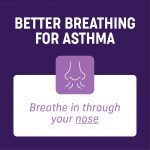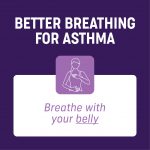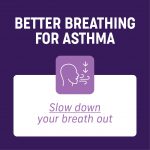If you’re struggling to breathe with a face mask, you’re not alone – here are some breathing techniques to help.
Over the past two years, face masks have become a staple of everyday life – serving as a welcome safety measure for many and even as a fashion item for a few. However, wearing one and breathing easily through one, is a problem for many of you, and in some cases, you’ve reported asthma flareups and attacks as a result of wearing a facemask.
Our team of Asthma Educators at 1800 ASTHMA have taken hundreds of calls about masks, and along with our Asthma and Mask Survey, it’s clear many in our community are still having problems with masks. And while vaccination rates in Australia go up, facemasks will still have a place in preventing COVID-19 spread.
You’ve told us that 70% of you like wearing a mask and that you feel safer and less affected by asthma due to pollen or cold air when wearing one. And 72% of the 1,235 of survey participants agree everybody should wear a facemask when outside their home.
However, the results also revealed some alarming concerns.

Some people found it hard to breathe and avoided wearing a mask or wore it incorrectly, while 55% of people had breathing difficulties when wearing a facemask.
And 33% of participants felt anxious while wearing a mask, which can also trigger asthma symptoms. We acknowledge this serious impact and aim to support people to have a better experience, so we spoke with Janet Bondarenko, a Senior Respiratory Physiotherapist, about what you can do to breathe easier when wearing a face mask.
Janet said practicing a few simple breathing exercises can help you feel more confident and in control of your breathing. This can help your asthma in general, can make you feel more relaxed, and reduce any anxiety you might feel when wearing a mask.
“Nose breathing, stomach breathing, and slow breathing are three exercises you can do. You can practice these at home without a mask, and then with a mask to help get more confident,” Janet said.
Nose Breathing 
“The best place to start is just breathing through your nose.” This sounds simple but if you have a habit of breathing through your mouth, it might take some practice. If you have any blockage in your nose that is stopping you from breathing through your nose, such as hay fever or polyps, ask your doctor for advice.
Stomach Breathing 
“Practice breathing with a relaxed upper chest and just using your stomach. Try to keep your chest still, so only your belly is moving up and down.” You might find lying down with your hands on your stomach the best way to practice this at first.
Slow Breathing
“Just slowing down your breathing can help,” Janet suggests. Focus on a gentle, slow exhalation. Ideally you should be breathing out for slightly longer than it takes you to breathe in. It can help to count in your head try breathing in for a slow count of two, then breathe out for a slow count of three.
Take a break
While wearing a mask might feel like it restricts your breathing, the mask itself doesn’t affect oxygen levels. But we know it can still feel uncomfortable, even if you don’t have asthma.
If you struggle to breathe when wearing a mask, you can take short breaks to relax and get your breath back. “Find a place where you’re on your own. Take it off, rest, relax. Do a few nose and stomach breaths to reset your breathing. Then put it back on.” Remember to only take off your mask by touching the ear-loops or ties and put it back on as soon as you can.
If you continue to experience breathing difficulty when wearing a mask, ask your doctor for advice.
How to wear a face mask properly
In places where you must wear a face mask, it is important to wear it properly.
The key points to remember are:
- Wash or sanitise your hands before touching your mask
- Hold the mask by the sides (ear loops or ties) to put it on
- Make sure the mask fully covers your mouth and nose. Make sure there are no gaps.
- Never touch the front of the mask.
The Australian Commission on Safety and Quality in Health Care has developed a factsheet to help you. Download full factsheet in English
This factsheet is also available in other languages at https://www.safetyandquality.gov.au/covid-19-resources/wearing-face-masks-community
For more information about COVID-19 and Asthma see: https://asthma.org.au/about-asthma/asthma-and-covid-19/
Link to side eye blog https://asthma.org.au/blog/is-not-wearing-a-mask-getting-you-side-eye/
Still struggling to wear a mask? We are here to help. Call 1800 ASTHMA for confidential asthma support and information.





 1800 278 462
1800 278 462



